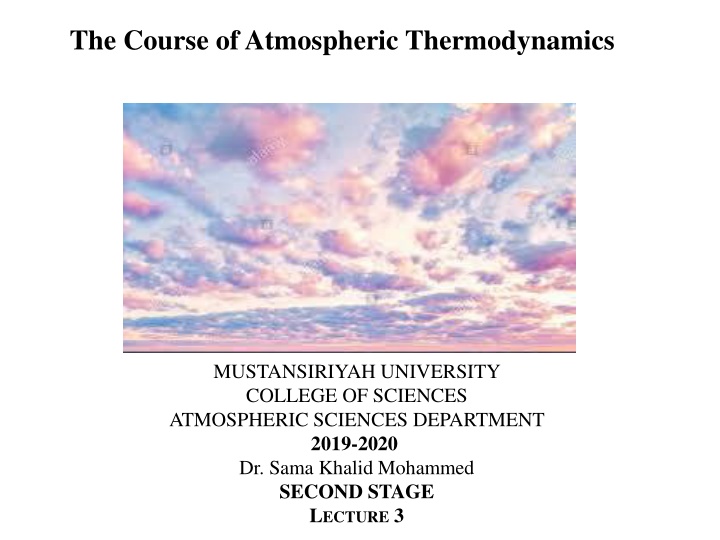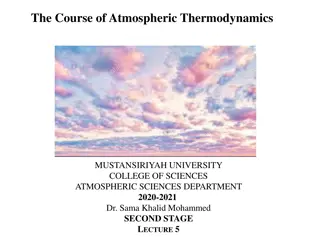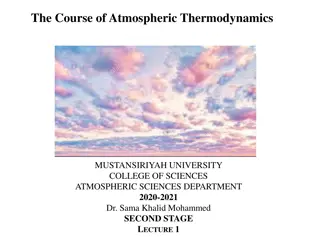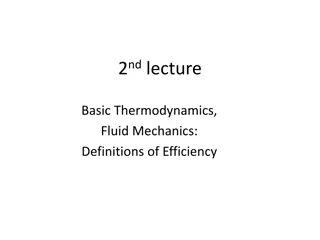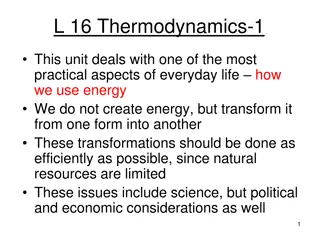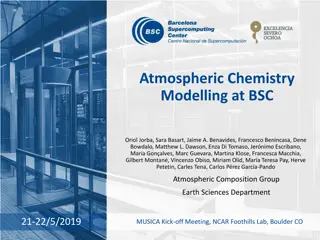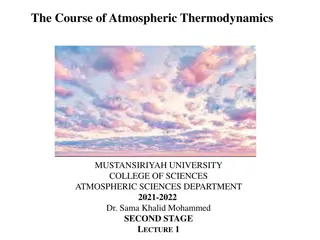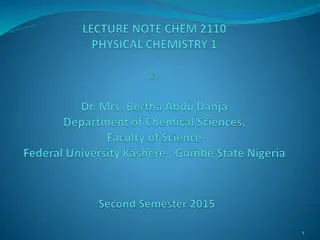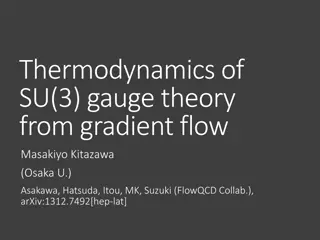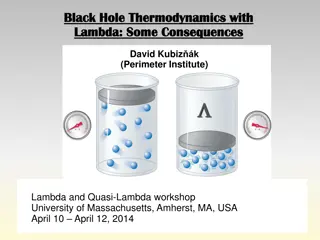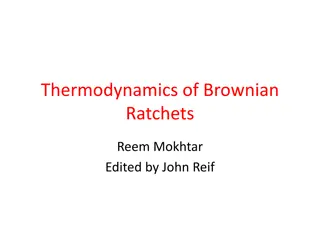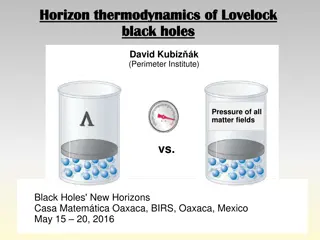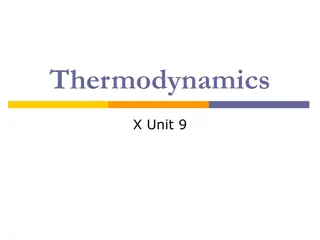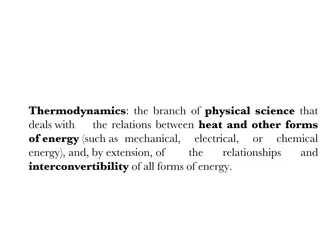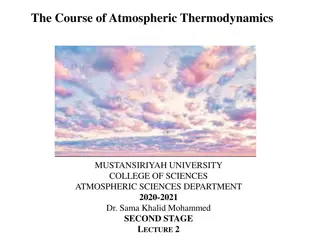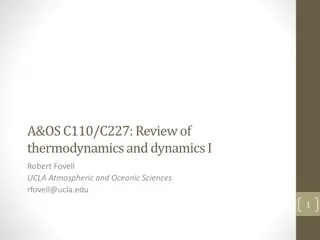The Course of Atmospheric Thermodynamics at Mustansiriya University
Atmospheric thermodynamics explores the properties of moist air, including partial pressure, vapor pressure, specific humidity, and more. Learn about the key concepts in this second-stage lecture led by Dr. Sama Khalid Mohammed at Mustansiriya University College of Sciences. Understand the relationships between different measures of humidity and the importance of virtual temperature in atmospheric studies.
Download Presentation

Please find below an Image/Link to download the presentation.
The content on the website is provided AS IS for your information and personal use only. It may not be sold, licensed, or shared on other websites without obtaining consent from the author.If you encounter any issues during the download, it is possible that the publisher has removed the file from their server.
You are allowed to download the files provided on this website for personal or commercial use, subject to the condition that they are used lawfully. All files are the property of their respective owners.
The content on the website is provided AS IS for your information and personal use only. It may not be sold, licensed, or shared on other websites without obtaining consent from the author.
E N D
Presentation Transcript
The Course of Atmospheric Thermodynamics MUSTANSIRIYAH UNIVERSITY COLLEGE OF SCIENCES ATMOSPHERIC SCIENCES DEPARTMENT 2019-2020 Dr. Sama Khalid Mohammed SECOND STAGE LECTURE 3
THIS LECTURE INCLUDING THE FOLLOWING ITEMS MOIST AIR PARTIAL PRESSURE VAPOR PRESSURE SATURATION VAPOR PRESSURE SPECIFIC HUMIDITY AND MIXING RATIO DEW POINT TEMPERATURE RELATIVE HUMIDITY KEY DIFFERENCE BETWEEN THE MEASURES OF HUMIDITY VIRTUAL TEMPERATURE
MOIST AIR In atmospheric thermodynamics, moist air is a mixture of dry air and any amount of water vapor. There are many expressions that can be used for moist air and they are: Vapor Pressure Absolute Humidity Specific Humidity Mixing ratio Dew point Temperature Relative humidity
PARTIAL PRESSURE In a mixture of gases, each gas species contributes to the total pressure. The pressure exerted by a single gas species is known as the partial pressure for that species. For a mixture of ideal gases, the partial pressure of any species can be found from the ideal gas law applied to that species only. For example, in air the partial pressures of O2, N2, and Ar would be The densities used in the above equations are partial densities.
PARTIAL PRESSURE The total pressure is equal to the sum of the partial pressures, and the total density is equal to the sum of the partial densities. The partial pressure of a species is proportional to the number of moles of the species. The partial pressure of a species can be found by multiplying the total pressure by the volume (or mole) fraction of the species. For example, the partial pressure of O2 is found by multiplying atmospheric pressure by 0.21 (21%).
VAPOR PRESSURE If you have a substance in liquid form, some of the molecules will escape into the vapor phase. The partial pressure due to these vapor molecules is known as the vapor pressure. Since the vapor pressure due to water molecules is proportional to the number of water vapor molecules in the atmosphere, vapor pressure is one measure of humidity, we usually denote vapor pressure as e Absolute humidity is defined as the mass of water vapor per unit volume. It is merely the density of the water vapor, v Vapor pressure is related to absolute humidity via the ideal gas law, e = v Rv T , where Rv is the specific gas constant for water vapor (461 J/kg K). The higher the amount of water vapor, the higher the absolute humidity.
SATURATION VAPOR PRESSURE The vapor molecules are colliding with each other. Some may stick together briefly to form tiny water droplets. However, these tiny water droplets are also constantly breaking apart. If enough vapor molecules are present, there may be enough collisions to form a stable population of liquid water droplets. This is called saturation, and the vapor pressure at this point is called the saturation vapor pressure (es).
SATURATION VAPOR PRESSURE The saturation vapor pressure is a function of temperature, and is given by the Clausius-Clapeyron equation where e0 is the vapor pressure at some known temperature T0, and L is the latent heat of vaporization. We typically use T0 = 273K, e0 = 611 Pa, and Lv = 2.5x106 J/kg. Riddles Heat energy (released /taken) in .. (evaporation/condensation) ..(from/into) the environment. SVP (saturation vapor pressure) Curve
SPECIFIC HUMIDITY AND MIXING RATIO Vapor pressure and absolute humidity are not very convenient expressions for humidity (at least for meteorologists). We define some other measures of humidity. Mixing ratio: The mass of water vapor per mass of dry air. This would be dimensionless (if expressed as kg/kg, or g/g). However, it is more often expressed as grams of water vapor per kg of dry air, so the units of mixing ratio are usually expressed as g/kg. Mixing ratio can be related to vapor pressure via where = Rd/Rv. The saturation mixing ratio, rs, is found by using es in the formula.
SPECIFIC HUMIDITY AND MIXING RATIO Specific humidity: The mass of water vapor per mass of air, it is very close to mixing ratio, since r << 1 (expressed as g/g or kg/kg). as shown in the following equation In meteorology, mixing ratio is used far more than specific humidity, and for most purposes the two can be considered as equivalent. Absolute and specific humidity are quite similar in concept.
DEW POINT TEMPERATURE The saturation vapor pressure is a function of temperature, and decreases with decreasing temperature. If you cool moist air, eventually the saturation vapor pressure will equal the vapor pressure, and saturation will be reached. The temperature at which this occurs is called the dew point, or dew point temperature. The dew point temperature can be found from the Clausius- Clapeyron equation by using the actual vapor pressure instead of the saturation vapor pressure, and solving for T. This gives
STOP & THINK ! Specific humidity, mixing ratio, vapor pressure, and dew point remain unchanged if the air parcel is heated or cooled at constant pressure. In other words, if I want to compare two air samples to find which has more water vapor, I can directly compare their mixing ratios, vapor pressures, specific humidity, or dew points. The one with the higher number will have more water vapor. I can compare the samples without worrying about whether they are at the same temperature or not (however, vapor pressure will have to be compared at the same air pressure)! This is not true of absolute humidity, which will change as the air parcel is heated or cooled. Thus, we are going to use another expression !!!
RELATIVE HUMIDITY Relative humidity, as its name implies, is a relative measure of humidity. It is defined as the ratio of the vapor pressure to the saturation vapor pressure, RH = e * 100 % se In terms of mixing ratio, relative humidity becomes This means we can use mixing ratio rather than vapor pressure to find relative humidity. Relative humidity (RH) (expressed as a percent) also measures water vapor, but RELATIVE to the temperature of the air.
RELATIVE HUMIDITY In other words, it is a measure of the actual amount of water vapor in the air compared to the total amount of vapor that can exist in the air at its current temperature. It tells us how close an air parcel is to saturation( It does not directly tell us how much water vapor is in the parcel!) A parcel with higher relative humidity may actually have less water vapor than another parcel with lower relative humidity! Warm air can possess more water vapor (moisture) than cold air, so with the same amount of absolute/specific humidity, air will have a HIGHER relative humidity if the air is cooler, and a LOWER relative humidity if the air is warmer. What we "feel" outside is the actual amount of moisture (absolute humidity) in the air.
KEY DIFFERENCE BETWEEN THE MEASURES OF HUMIDITY There are two ways to change the relative humidity, or absolute humidity of an air parcel: Add or subtract water vapor. Change the temperature. There is only one way to change mixing ratio, specific humidity, vapor pressure, or dew point (assuming pressure is constant): Add or subtract water vapor.
VIRTUAL TEMPERATURE Moist air can be considered a mixture of two ideal gases (dry air and water vapor). The ideal gas law for moist air is By manipulate the above equation , we can define a new temperature, Tv ( the virtual temperature) For moist air we can use the ideal gas law for dry air, only using the virtual temperature in place of the actual temperature. The virtual temperature is the temperature that dry air would have if its pressure and density were equal to those of a given sample of moist air , and it can be expressed as: Tv= (1 + 0.61 q ) T Virtual temperature is always greater than or equal to the actual temperature.
VIRTUAL TEMPERATURE The addition of water vapor causes the air to behave as though it is warmer. This makes sense, because moist air is lighter than dry air. we can write virtual temperature using mixing ratio as Tv (1 + 0.61 r ) In all of the preceding equations for virtual temperature we must use the absolute (Kelvin) temperature and the dimensionless form of mixing ratio or specific humidity. However, there is an approximate formula for virtual temperature in Celsius that uses the dimensional (g/kg) form of mixing ratio or specific humidity. This formula is Tv ( C ) T ( C) +r (g/kg) 6
